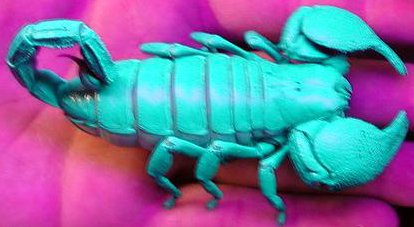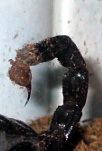|
Exoskeleton
The body of the scorpion is covered in chitin (a
protein) which acts as the scorpions armor; the
armor defends the scorpion from predators and
other bodily harm.
One interesting quality emperor scorpions
possess is the ability to glow under ultraviolet
light, such as a blacklight. Unfortunately,
nobody knows exactly why scorpions glow, but there are a few theories that would
explain this. One is that since a lot of insects
see ultraviolet light, the scorpions may act as
a bug trapper. The insect would see the
scorpion glowing, and head to it, only to get
eaten; the scorpion would not even have to
actively hunt. Another theory is that it may
give the scorpion the ability to see ultraviolet
wavelengths, allowing it to hide more easily
during the daytime. If you were to loose a
scorpion, all you would have to do is walk
around with a black light and you will clearly
see the scorpion glow.
glow, but there are a few theories that would
explain this. One is that since a lot of insects
see ultraviolet light, the scorpions may act as
a bug trapper. The insect would see the
scorpion glowing, and head to it, only to get
eaten; the scorpion would not even have to
actively hunt. Another theory is that it may
give the scorpion the ability to see ultraviolet
wavelengths, allowing it to hide more easily
during the daytime. If you were to loose a
scorpion, all you would have to do is walk
around with a black light and you will clearly
see the scorpion glow.
Eyes
Scorpions have a lot of eyes, usually between 4
and 8. Surprisingly, however, scorpions have
very poor vision. Their eyes are mainly used to
distinguish lightness from darkness. They can’t
really make out objects, and as a result they
have to use other sensory organs to survive.
Scorpions have tons of sensitive microscopic
hairs that cover their entire body. These hairs
allow the scorpion to get a sense of their
environment and hunt. With these hairs, the
scorpions can tell about how big a prey item is
and where it is located. It does not really
matter that scorpions have bad eyesight because
they are nocturnal anyway, which means that they
are active at night, and rest during the day.
Claws
The scorpions claws (“chelae”) are nothing more
than amended pedipalps of other arachnids.
Scorpions primarily use them for defense and for
the capture of prey, which they crush and grind
up. Emperor scorpions have the largest claws of
any scorpion. A general rule is that scorpions
that have larger claws have mild venom, while
scorpions with slender claws usually possess
lethal venom. The claws also have long sensory
hairs that sense vibrations and air movement.
Legs
All species of scorpions each have 8 walking
legs. Each of these legs consists of 8 segments:
coxa, trochanter, femur, patella, tibia,
basitarsus, telotarsus, and pretarsus. The
scorpions legs work like a hydraulic machine. If
the scorpion wants to move a leg, he has to
adjust his blood pressure and let blood force
the joints open. There are no extensor muscles
to straighten the legs.
Chelicerae
Instead of teeth, scorpions have what is known
as chelicerae. These are powerful muscled
appendages that tear and grind up food.
Scorpions can not internally digest food, and as
a result they must digest their prey
externally. They do this by barfing digesting
enzymes onto their prey. The liquified prey is
then sucked into the scorpion.
Sting
The st ing
of the scorpion is located at the top of the
metasoma along with the venom glands. When the
scorpion stings, it functions a lot like a
hypodermic needle. The venom flows through a
hollow hole in the sting which is controlled by
muscles. The scorpion can control how much if
any venom it injects; it is very possible for a
scorpion to sting you without releasing any
venom. ing
of the scorpion is located at the top of the
metasoma along with the venom glands. When the
scorpion stings, it functions a lot like a
hypodermic needle. The venom flows through a
hollow hole in the sting which is controlled by
muscles. The scorpion can control how much if
any venom it injects; it is very possible for a
scorpion to sting you without releasing any
venom.
Breathing
All species of scorpion do not have any trachea
or lungs, but they do have 4 pairs of book lungs
which are contained in a chamber called the
atrium.
Blood/Heart
Scorpions have a open circulatory system and
have no blood vessels, as a result the blood
fills the whole body cavity. The heart simply
pumps blood from one side of the scorpion to the
other, carrying oxygen and nutrients to all of
the cells.
|













